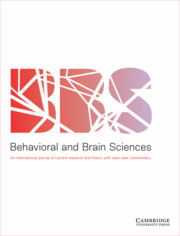No CrossRef data available.
Article contents
Infants' representations of causation
Published online by Cambridge University Press: 19 May 2011
Abstract
It is consistent with the evidence in The Origin of Concepts to conjecture that infants' causal representations, like their numerical representations, are not continuous with adults', so that bootstrapping is needed in both cases.
Information
- Type
- Open Peer Commentary
- Information
- Copyright
- Copyright © Cambridge University Press 2011
References
Baillargeon, R., Kotovsky, L. & Needham, A. (1995) The acquisition of physical knowledge in infancy. In: Causal cognition. A multidisciplinary debate, ed. Sperber, D. & Premack, D., pp. 79–115. Clarendon.Google Scholar
Barrett, T. M., Davis, E. F. & Needham, A. (2007) Learning about tools in infancy. Developmental Psychology
43(22):352–68.CrossRefGoogle ScholarPubMed
Berthier, N. E., De Blois, S., Poirier, C. R., Novak, M. A. & Clifton, R. K. (2000) Where's the ball? Two- and three-year-olds reason about unseen events. Developmental Psychology
36(3):394–401.CrossRefGoogle ScholarPubMed
Butterfill, S. (2009) Seeing causes and hearing gestures. Philosophical Quarterly
59(236):405–28.CrossRefGoogle Scholar
Goldenberg, G. & Hagmann, S. (1998) Tool use and mechanical problem solving in apraxia. Neuropsychologia
36:581–89.CrossRefGoogle ScholarPubMed
Hood, B., Cole-Davies, V. & Dias, M. (2003) Looking and search measures of object knowledge in preschool children. Developmental Science
29(1):61–70.Google Scholar
Johnson-Frey, S. H. (2004) The neural bases of complex tool use in humans. Trends in Cognitive Sciences
8(2):71–8.CrossRefGoogle ScholarPubMed
Liberman, A. M. & Mattingly, I. G. (1985) The motor theory of speech perception revised. Cognition
21(1):1–36.CrossRefGoogle ScholarPubMed
Liberman, A. M. & Mattingly, I. G. (1991) Modularity and the effects of experience. In: Cognition and the symbolic processes: Applied and ecological perspectives, ed. Hoffman, R. R. & Palermo, D. S., pp. 33–38. Erlbaum.Google Scholar
Lockman, J. J. (2000) A perception-action perspective on tool use development. Child Development
71(1):137–44.CrossRefGoogle ScholarPubMed
Menzies, P. & Price, H. (1993) Causation as a secondary quality. British Journal for the Philosophy of Science
44(2):187–203.CrossRefGoogle Scholar
Saxe, R. & Carey, S. (2006) The perception of causality in infancy. Acta Psychologica
123:144–65.CrossRefGoogle ScholarPubMed
Spelke, E. & Van de Walle, G. (1993) Perceiving and reasoning about objects., In: Spatial representation: Problems in philosophy and psychology, ed. Eilan, N., McCarthy, R. & Brewer, B., pp. 132–61. Oxford University Press.Google Scholar
Wang, S.-H., Kaufman, L. & Baillargeon, R. (2003) Should all stationary objects move when hit? Developments in infants' causal and statistical expectations about collision events. Infant Behavior and Development
26:529–67CrossRefGoogle ScholarPubMed
Woodward, J. (2003) Making things happen: A theory of causal explanation. Oxford University Press.Google Scholar


Target article
Infants' representations of causation
Related commentaries (1)
Précis of The Origin of Concepts